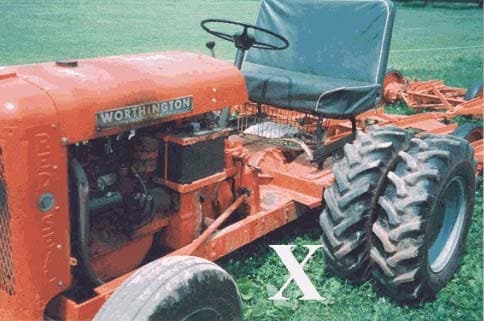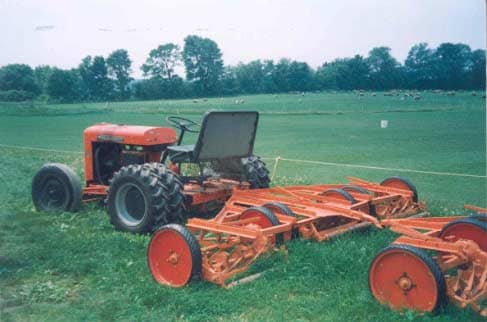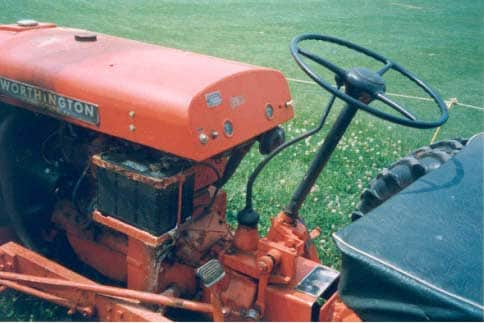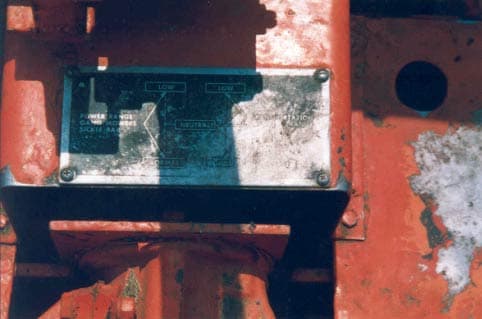Country Club Maintenance Employee Run Over by a Tractor While Training a New Employee - Massachusetts
Investigation: # 01-MA-020-01
Release Date: June 30, 2003
SUMMARY
On June 20, 2001, a 72-year-old male employee of a country club maintenance department (the victim) was fatally injured while showing a new employee how to operate a tractor. The victim, standing in between the left front and left rear wheels of the tractor had the new employee start the tractor, then reached over the new employee and placed the tractor in what he thought was neutral. The victim then instructed the new employee to take his foot off the clutch, causing the tractor to lunge forward running over the victim. A call was placed for emergency assistance and emergency responders arrived within minutes to the site. The victim, conscious and alert requested to be transported to a local hospital. He was subsequently transported to a larger hospital where he died a few hours later. The Massachusetts FACE Program concluded that to prevent similar occurrences in the future, employers should:
- evaluate the safety of all company owned tractors and retrofit older models with new safety equipment in accordance with manufacture’s specifications
- develop, implement, and enforce a standard operating procedure (SOP), which would include but not be limited to, prohibiting employees from standing in-between the front and rear wheels of a tractor while starting the tractor or while the tractor is running
- develop, implement, and enforce a standard employee training program for training equipment operators
- develop, implement and enforce a written comprehensive health and safety program
INTRODUCTION
On June 21, 2001, the Massachusetts FACE Program was notified by a local police department through the 24-hour Occupational Fatality Hotline, that on June 20, 2001, a 72-year-old male maintenance worker for a private country club was fatally injured when he was run over by a tractor. An investigation was immediately initiated. On June 28, 2001 the Massachusetts FACE Program Director and an investigator traveled to the country club where the victim’s manager was interviewed. The police report, death certificate and an OSHA Fatality/Catastrophe Report were obtained during the course of the investigation.
The employer, a private country club, had been in business approximately 37 years at the time of the incident. The country club maintenance department employed 15 workers, including the victim, who all shared a variety of maintenance tasks. The club did not have a designated individual in charge of safety nor a comprehensive health and safety program. Employee training provided by the employer had been based on the Environmental Protection Agency (EPA) Worker Protection Standard, which is limited to the hazards of working with chemicals and pesticides.
The victim, a retired heating repair service technician, had been employed full-time with the country club for approximately five years. His training was primarily on-the-job and his manager was not sure if he had prior experience operating a tractor. There is no union representation at this facility.
INVESTIGATION
The country club, established in 1964, was family owned and operated and had approximately 350 members. The club was comprised of approximately 115 acres and included an 18-hole golf course, swimming pool, banquet facilities, and a pro-shop. The banquet facilities and the pro-shop were not managed by the country club.
The maintenance department was managed by one of the three country club owners. There were no permanently assigned tasks for the maintenance department employees, typically they performed any task that needed to be completed. Training for maintenance department employees had been on-the-job and conducted by the maintenance department manager/owner or senior employees.
The country club owned four tractors, the oldest was involved in the incident, and the other three tractors were manufactured in 2000, 1995 and the early 1970’s. The tractor involved in the incident had been purchased used in 1964 and management was not sure of the exact year the tractor had been built, but estimated it to be 1950. The operator’s manual that the country club used for the tractor was for a 1957 model, the closest year they could find to the estimated year of manufacture. The tractor was a two-wheel drive model with a four-cylinder gasoline flat head, standard shift engine and dual rear wheels (Figure 1). The total weight of the tractor was approximately 2100 pounds, which included the tractor’s weighted rear wheels, which were 135 pounds per side. The manufacturer designed the tractor with weighted rear wheels to increase the tractor’s traction. In addition, the tractor was equipped with a bench style seat. The tractor lacked many newer safety features such as seatbelts, safety neutral start switch, and a roll over protective structure.
The victim had been asked by the maintenance department manager/owner to show a new employee how to mow the roughs. The new employee, a 22-year-old male, had been employed with the country club for approximately four weeks, and, according to the maintenance department manager/owner, he had some previous experience driving a standard shift vehicle.
Mowing the roughs consisted of operating the standard shift tractor while pulling a gang mower (Figure 2). The gang mower was a two-tiered manual mower with cutting blades that rotated when the mower was being pulled and the blades were engaged.
The victim drove the tractor with the gang mower hitched to it, blades not engaged, to the 10th fairway while the new employee followed in a golf cart. At the 10th fairway, with the tractor turned off, the victim showed the new employee how to engage the gang mower blades. Then the victim, standing on the left side of the tractor in-between its front and rear wheels, had the new employee sit in the operator’s seat, depress the clutch and start the engine. The victim then reached over the new employee and “wiggled” the transmission shift stick to place the tractor in neutral, but mistakenly had placed it in gear (Figures 3 and 4). According to the maintenance department manager, the victim then informed the new employee that the tractor was in neutral and instructed him to let up on the clutch. When the new employee let up on the clutch the tractor lunged forward approximately six feet running over the victim’s mid section (torso/hip area) with the weighted left dual rear wheels. The new employee stopped the tractor by pulling out the choke knob.
A call was placed for emergency assistance and emergency responders arrived minutes after the call. The victim, conscious and alert, mentioned that he was experiencing a little pain in his hip and requested to be transported to a small local hospital. Upon arrival, hospital staff realized the extent of his injuries and the victim was transported to a larger hospital where he died a few hours later.
CAUSE OF DEATH
The medical examiner listed the cause of death as multiple trauma.
RECOMMENDATIONS/DISCUSSION
Recommendation #1: Employers should evaluate the safety of all company owned tractors and retrofit older models with new safety equipment in accordance with manufacture’s specifications.
Discussion: The task of mowing the roughs was performed with the country club’s oldest tractor. This tractor, manufactured approximately in 1950, did not have many of the newer safety features such as a neutral start safety switch, rollover protective structure and seatbelts. If a retrofit neutral start safety switch had been installed on the tractor, the tractor would not have been able to start in gear. This would have reduced the possibility of the tractor moving unexpectedly if inadvertently placed or left in gear. Retrofitting older tractors with newer safety technology and training tractor operators how to properly use the safety equipment may reduce the chance of injury.
In addition, if an older tractors lacks multiple newer safety features and can not be retrofitted with new safety technology then the employer should consider removing the older tractor from commission and purchasing a newer tractor that is already equipped with the new safety features.
Recommendation #2: Employers should develop, implement, and enforce a standard operating procedure (SOP), which would include but not be limited to, prohibiting employees from standing in-between the front and rear wheels of a tractor while starting the tractor or while the tractor is running.
Discussion: A standard operation procedure (SOP) should explain the safe and proper way of operating a tractor. In this case the SOP should include that no employee, including tractor operators, should stand in-between the front and rear wheels of a tractor while starting the tractor or while the tractor is running, regardless if there is a person in the operator’s seat. The SOP should specifically include but not be limited to that a tractor should only be started when:
- the operator is seated in the operator’s seat and
- all individuals are clear of the front, rear and sides of the tractor and any attachments.
In addition, before starting the tractor, the operator should check for and warn all individuals in close proximity that the tractor is going to be operated. When exiting a running tractor, the operator should be certain that the transmission is in park or neutral with the emergency brake engaged. The manufacturer’s instructions in the operator manual is a good source of information on how to safely and properly operate the equipment.
Recommendation #3: Employers should develop, implement, and enforce a standard employee training program for training equipment operators.
Discussion: It is common practice in many facilities to have experienced employees show less experienced and new employees how to operate equipment. Before more experienced employees provide training to others they should go through training themselves. Typically, this training is called train-the-trainer. In workplaces that perform tasks where outside train-the-trainer courses are not available, such as a mowing roughs at a country club, employers could develop their own version in the form of a standard employee training procedure for trainers.
In this case, a standard employee training program for training employees on how to operate a tractor and mowing roughs should include hazard identification. For example, the hazards of being located next to a tractor while an inexperienced employee is seated in the operator’s seat with the tractor’s engine running. In addition, the standard employee training program should include training on the procedures that are to be followed for safe tractor operation such as how to start, operate, use attachments like gang mower, and how to safely shut down the tractor. The SOP for tractor operation discussed in recommendation #2 should be used in combination with the standard employee training program.
Recommendation #4: Employers should develop, implement and enforce a written comprehensive health and safety program.
Discussion: The country club did not have a comprehensive health and safety program nor an individual designated as responsible for employee health and safety. Employers should, with employee input should develop, implement and strictly enforce a written comprehensive health and safety program. This program should identify who is responsible for workplace safety and include written procedures for tasks employees will perform, current health and safety information, and worker health and safety training.
In this case, the health and safety training program should include, but not be limited to, the SOP for safe tractor operation (discussed in recommendation #3) on how to properly train employees in equipment operation. Attached is a summary of OSHA’s proposed safety and health program rule for employers, which was developed by OSHA to help minimize the number of job-related fatalities, illnesses, and injuries.
REFERENCES
Code of Federal Regulations, Labor 29 Parts 1928.51 Roll-over protective structures (ROPS) for tractor used in agriculture operations., SubPart C Roll-Over Protective Structures.
Clemson University Cooperative Extension Service, Farm Safety and Health, South Carolina http://www.clemson.edu/farmsafetyandhealth/tractor.htm (Link no longer available 4/1/2009)
Code of Federal Regulations, 29 CFR 1900.1 Docket No. S&H-0027 Draft Proposed Safety and Health Program Rule, Government Printing Office, 1998
Equipment Manufacturers Institute, Agricultural Tractor, Chicago, Illinois, 1990

Figure 1 – Victim’s location between the front and rear dual weighted wheels

Figure 2 – Tractor and gang mowers

Figure 3 – Tractor operator’s area (steering wheel and gearshift)

Figure 4 – Tractor gear shift pattern
|
SUMMARY OF OSHA’S DRAFT PROPOSED |
|
Core elements
Basic obligations
Employee participation
Identify and assess hazards to which employees are exposed
Investigate safety and health events in the workplace
|
Safety and health program record keeping
Hazard prevention and control
Information and training
Program evaluation and maintenance
Multi-employer workplaces
|
Date issued November 23, 1998. Full text available on https://www.osha.gov/dsg/topics/safetyhealth/nshp.htmlexternal icon. (Link updated 3/20/2013)
To contact Massachusetts State FACE program personnel regarding State-based FACE reports, please use information listed on the Contact Sheet on the NIOSH FACE web site Please contact In-house FACE program personnel regarding In-house FACE reports and to gain assistance when State-FACE program personnel cannot be reached.
